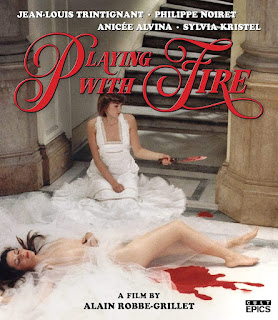Playing with Fire
Certain filmmakers reach a point in their career in which audience enjoyment of their work doesn’t even factor into the equation. To quote Quentin Tarantino, directors like Jean-Luc Godard and David Lynch have “disappeared so far up their own asses that I have no desire to see another movie from them until I hear something different.” It’s a crude and obviously personal opinion, but it does call to attention a certain kind of auteur who makes movies for themselves rather than the paying public.
But to some cinephiles, that can be an enjoyable challenge. And late director Alain Robbe-Grillet has been throwing down the gauntlet since first his first work, Last Year at Marienbad (1961), was adapted by Alain Resnais. Never one to stick to a traditional narrative format, Robbe-Grillet went even further off the rails when he starting making his own films, playfully toying with audiences by deconstructing not just genre conventions, but the cinematic form itself.
1975’s Playing with Fire successfully reunites him with the iconic actor Jean-Louis Trintignant. But by the time of release, it was Sylvia Kristel (Emmanuelle) who became the selling point in a film that showcased sexuality in a far more twisted and disturbing way than her international softcore success. Cutting between various characters’ perspectives, several concurrent timelines and constant breaking of the fourth wall, Robbe-Grillet’s film is playful but perverse, using and abusing the female form with flippantly misogynistic disdain.
Those are some ten-dollar words. But Playing with Fire is the sort stream-of-consciousness filmmaking that demands your attention. As for the plot, Philippe Noiret stars as banker George de Saxe whose daughter (Anicee Alvina) becomes the target of kidnappers selling their victims into high-priced sexual slavery. Until a ransom is paid (and sometimes if it’s not) each woman is housed in an elaborate brothel that specializes in torture, rape, role-playing and bestiality, carefully staged to recreate classic artwork of a bygone era.
Like Robbe-Grillet’s earlier films, actors switch out roles and characters as the plot progresses, leaning towards a dreamlike absurdism in which nothing can truly be described as “reality.” In fact, the film opens with Noiret narrating his own incestuous fantasies, lending credence to the idea that he’s simply a stand-in for Robbe-Grillet’s own act of cinematic sabotage. And like Godard, who loved to wrap his non-linear experiments up in the trappings of familiar genres, the director is able to drag his audience by the nose thanks to copious amount of female flesh on display.
Is it a farce? A comedy? A perverse family tragedy? Playing with Fire refuses to come clean. And that can be a frustrating experience in a world in which most films leave no question unanswered. But Robbe-Grillet is making “art.” Whether the composition is pulled completely from his own ass is still a matter of opinion.
God bless Cult Epics for putting out such a filthy piece of uncompromising intellectual smut either way. The new 2K transfer from the original negative is a real stunner and extras include an interview with wife Catherine Robbe-Grillet, trailers, collectible booklet and an essential commentary track from Tim Lucas who brilliantly breaks down the film’s esoteric and erotic charms.




Comments
Post a Comment